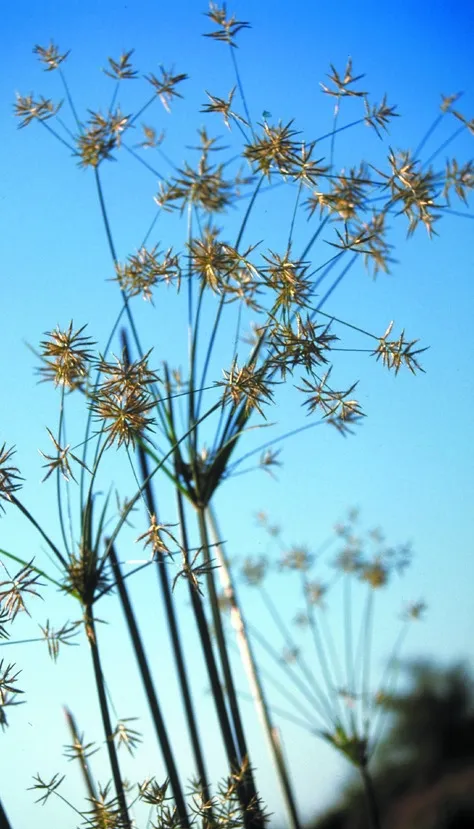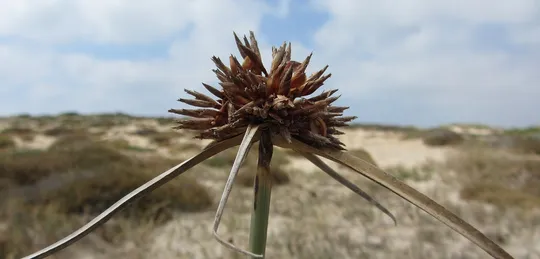Broad-leaved Nut-grass
Cyperus latifolius
Cyperus latifolius was collected in Israel for the herbarium only three times, always from the Sharon region: “Batih Pond”, “near Hadera” and “near Gan Shmu’el”. All the collections are from 1926-1927 and 1932. It is very likely that the three samples noted in the herbarium records were gathered in the same place – Batih Pond. This species was already noted in 1974 (Agami and Dafni, 1975) as extinct, and all efforts made by botanists in the country to find it again in the Sharon failed. In the Sharon rare species survey in 1994, special attention was focused to the subject but the species was not found, despite being a conspicuous species that is hard to miss.
Perennial clear water pools; in Africa it also grows on stream banks and in large swamps.
For the genus, see Cyperus corymbosus.
Cyperus latifolius is similar in its outward appearance to C. dives and to C. alopecuroides, but is generally shorter than them. C. dives and C. alopecuroides have compound inflorescences of spikelets, unlike C. latifolius whose inflorescence is a simple raceme of spikelets. In its inflorescence, C. latifolius is close to C. articulates and C. corymbosus, but it has long, broad involucral bracts, versus short or atrophied involucral bracts in other species.
Cyperus latifolius belongs to a group of tropical Cyperus for whom the Jordan Valley and the coastal plain are the extreme northern points in their global distribution: C. corymbosus, C. articulates, C. papyrus and more. In the past eighty years, following development in the Sharon, marsh drainage, agricultural development and wetland exploitation and pollution, many of the wetland habitats in which these tropical species grew were destroyed. Because of the peripheral location and their important biogeographic status of these species, it is important to prevent their extinction and the extinction of their habitats. Of this group, C. latifolius has become extinct in Israel.
A Cyperus latifolius population should be reintroduced to the Batih Pond, together with the restoration of the water regime to its previous state. The reintroduced population should be monitored.
Cyperus latifolius is an African tropical species. Until the species became extinct, Israel was the only place in Asia that the species grew. In Africa, it grows in Sudan, in South Africa and in the entire equatorial region of East Africa, westwards to Nigeria.
Cyperus latifolius is a tropical Cyperus, which had formerly grown in single site in Israel, in the Batih Pond near Hadera. It became extinct after the establishment of the state of Israel. This was the northernmost site of this African species, as well as the only site in the entire Middle East. It symbolizes the great importance of coastal plain wetlands as habitats for African tropical elements and as the northernmost distribution limit or migration corridor for aquatic tropical plants to the eastern area of the Middle East and northwards.
Another species, C. polystachyos, it probably episodic. This specie was also observed (only once) in the Batih Pond, and raises the question of why C. latifolius was classified as a red plant and its reintroduction (with the associated expense) was recommended, whereas C. polystachyos is considered episodic. It must be admitted that this decision was largely arbitrary, reflecting the difficulty of decision making regarding species that are very rare and for whom there is limited and uncertain information. However, the decision regarding the different status of the two Cyperus species is supported by the fact that C. polystachyos is an annual and sometimes bi-annual plant with the character of a “noxious weed” that was collected only once in 85 years. C. latifolius on the other hand, is a perennial species that was collected three times in the same area, which indicates a stable population.
Current Occupancy Map
| 1000 squre meter pixel | 5000 squre meter pixel | 10000 squre meter pixel | |
|---|---|---|---|
| number of observations | 0 | 0 | 0 |
| in total pixels | 0 | 0 | 0 |
| Family | Cyperaceae |
| Classification | On the endangered species list |
| Ecosystem | Coastal area |
| Chorotype | Tropical |
| Conservation Site | Batih Pond near Hadera |
| Rarity |
1
6
6
|
|---|---|
| Vulnerability |
0
4
4
|
| Attractiveness |
0
2
4
|
| Endemism |
0
0
4
|
| Red number |
1
-1.0
10
|
| Peripherality | S |
| IUCN category | DD EW EX LC CR EN VU NT |
| Threat Definition according to the red book | Extinct |
 Based on:
Based on:





